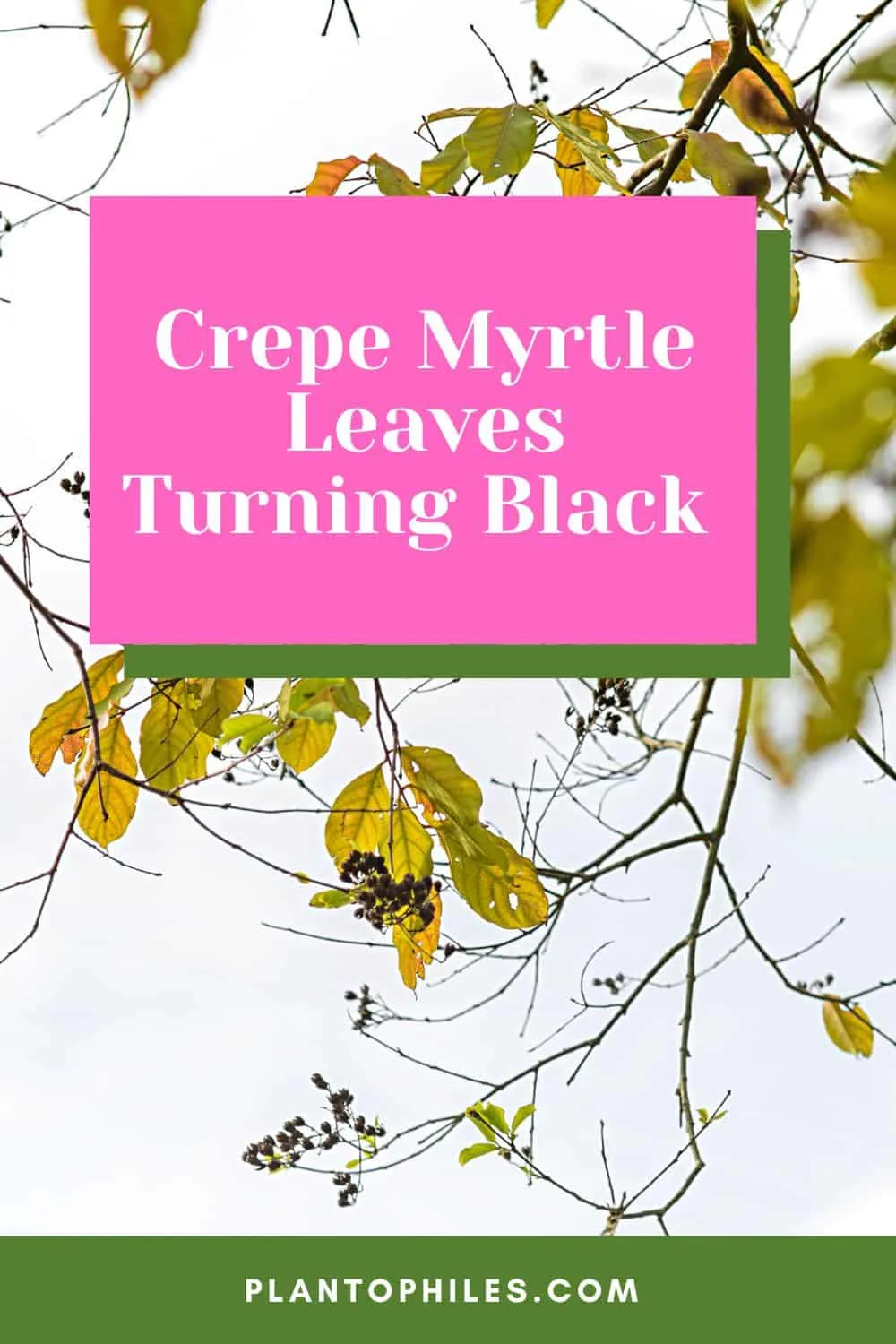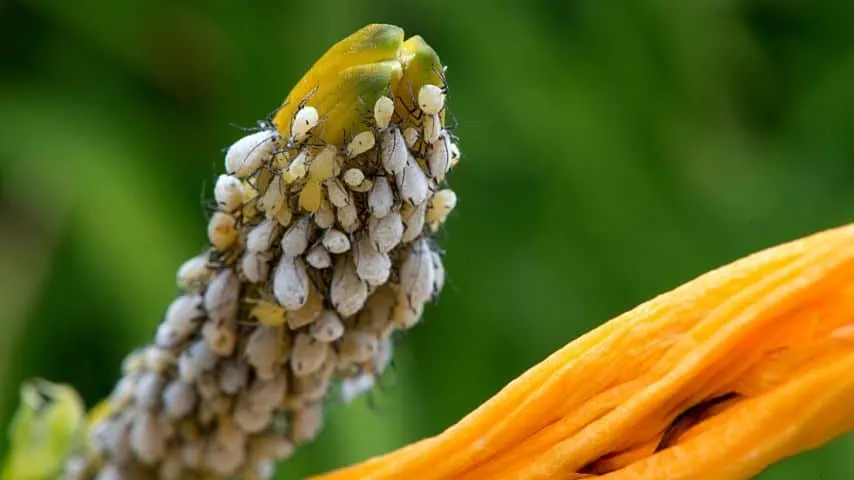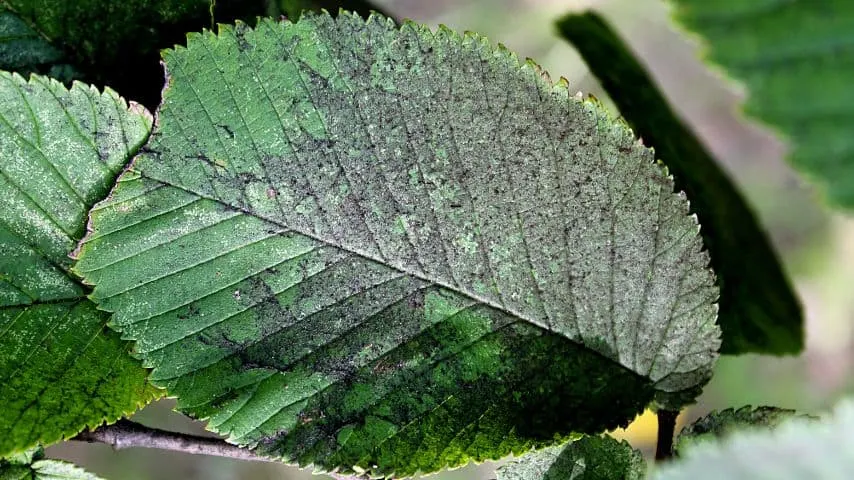Unless you have an unusually morbid outlook on life, like most everyone else, the sight of your plants’ usually vibrant and healthy green leaves turning a funeral, gloomy black is alarming, more so if you don’t know why it is happening.
The good news is that although the condition is horribly unsightly, it is easily treated and shouldn’t cause the plant any lasting damage if dealt with in good time.
In this article, I will describe what causes the problem and how to deal with it effectively for a long-term solution.
Table of Contents
Crepe Myrtle Leaves Turning Black
Crepe Myrtle leaves turn black due to a fungus that results in a condition called “sooty mold.” The fungus’s infection vector (how it gets onto the plant and causes an infection) is well understood, and fortunately, there are effective means of dealing with the fungus.

How your Crepe Myrtle Gets Sooty Mold
You might be surprised to hear that the problem of sooty mold begins with Crepe Myrtle aphids and Azalea Bark Scale.

Both of these pests are particularly active between late May and early September, and both are adapted to feed on Crepe Myrtle, although Bark Scale does even better on Azaleas.
The two pests feed on Crepe Myrtles’ sugary sap, but neither nuisance can fully digest their diet of sugary sap and so end up excreting something called “honeydew,” a waste product that contains a high degree of undigested sugar.
Once honeydew builds up on the stems and spines of Crepe Myrtle, along comes an array of fungi– mainly Cladosporium and Alternaria – to gobble up this free meal of high-calorie sugar.
These fungi are colored dark ash. As the fungus builds up on Crepe Myrtle’s leaves, the plant becomes black and oily as if covered in soot, hence the name “sooty mold.”

Incredibly, the fungus does not attack the host plant, instead happily existing solely on the nutrition provided by the aphids’ and bark scales’ waste.
The fundamental independence of the fungus that causes sooty mold and your Crepe Myrtle’s leaves is that the fungus comes off without difficulty.
You can even scrape it off with a fingernail, often revealing green, healthy leaves beneath the mold layer.
The Damage Sooty Mold Does to Crepe Myrtle
You probably know that chlorophyll causes the “green” in green foliage. Chlorophyll is a complex enzyme that allows plants to convert sunlight into energy.
There’s like a feedback loop in the process.
Each green plant produces the chlorophyll it needs to feed itself, which uses up the chlorophyll in the plant.
However, the energy gained from the sunlight allows the plant to make more chlorophyll, which means the plant can absorb more sunlight, which means more chlorophyll, and so on.
Break the cycle, and the plant might be in grave danger.
When sooty mold covers Crepe Myrtle’s leaves, the tree can no longer convert sunlight into energy and thus can starve due to a lack of energy.
However, because the plant’s chlorophyll is not used up converting sunlight into energy, the leaves underneath the sooty mold remain green, and most might even look healthy.
In summary, sooty mold is not particularly harmful to Crepes Myrtle unless and until it has spread over a majority of leaves and is, therefore, significantly depriving the victim of sunlight.
Outside of the wild, gardeners rarely, if ever, allow this to happen, so sooty mold is more an irritant than anything else.
Why Crepe Myrtle Appears Diseased When Attacked by Sooty Mold
There is a general axiom (truthful saying) in science and philosophy that correlation is not causation. This rather academic and somewhat pompous proverb serves as a reminder to never confuse “A happens when B happens” with “A happens because B happens.”
“When” and “because” don’t have the same meaning!
For example, here in the US, the number of shark attacks yearly rises and falls with the sale of ice cream. When folks buy more ice cream, more people get bitten by sharks.
When folds buy less ice cream, fewer people get bitten by sharks. It never fails.
Of course, I don’t think ice cream causes shark attacks, and I’m pretty sure neither do you. So what to make of this relationship?
If you think about it, outlets sell more ice cream when the weather is warm, which is in summer. Summer is also when people go to the beach and swim in the ocean, where they sometimes encounter sharks.
So ice cream shark attacks have a “correlation,” not a “causation.”
It turns out that sooty mold and distressed Crepe Myrtle is also a correlation, not causation.
Crepe Myrtle’s diseased circumstances come from the same source as sooty mold, which is aphids or bark scale.
Both aphids and bark scale literally suck the sap out of the tree/bush to the point where the poor thing can’t keep itself well-fed. Eventually, the plant gets weaker and unhealthier until it can no longer withstand the attack and succumbs to disease or the elements.
In short, it’s not the sooty mold doing the damage, it’s the underlying infestation of pests.
Dealing with Sooty Mold on Crepe Myrtles
To deal with mold on your Crepes Myrtle, deal with the reason the mold exists: honeydew.
Destroy the honeydew to destroy the sooty mold. To get rid of the honeydew, get rid of the critters producing it, i.e., the aphids and the bark scale.
There are several good options for dealing with Crepe Myrtle pests, and I don’t think I can do better than recommend a systemic insecticide that you can inject into the soil after winter has set in or during early spring.
Used properly, these insecticides (available from Walmart or Amazon) will protect your plants for up to one year.
Frequently Asked Questions about Crepe Myrtle Leaves Turning Black
How do I get rid of sooty mold naturally using baking soda?
A remedy that works for many gardeners is a homemade baking soda spray solution. Mix 1 tbsp of baking soda with 1 tsp of a dish – or insecticidal – soap into 1 gallon of water. Don’t substitute soap with detergent as it’ll damage the plant. Spray the affected plants once weekly or every fortnight.
How do I remove sooty mold naturally using milk?
Add room-temperature water and milk together using 2-parts water to 1-part milk ratio. For this method, there’s no need for special dairy, so just use ordinary store-bought milk. Spray the affected plants once a week or once every fortnight and keep going until the plant is fully recovered.
Conclusion Crepe Myrtle Leaves Turning Black
A crepe myrtle leaves Turning black strongly indicates that the plant is suffering from a fungal infection called sooty mold. This shows that your tree or shrub is being attacked by tiny critters. Getting rid of these critters will free your plant of the sooty mold and protect the tree from further harm.

Daniel has been a plant enthusiast for over 20 years. He owns hundreds of houseplants and prepares for the chili growing seasons yearly with great anticipation. His favorite plants are plant species in the Araceae family, such as Monstera, Philodendron, and Anthurium. He also loves gardening and is growing hot peppers, tomatoes, and many more vegetables.


